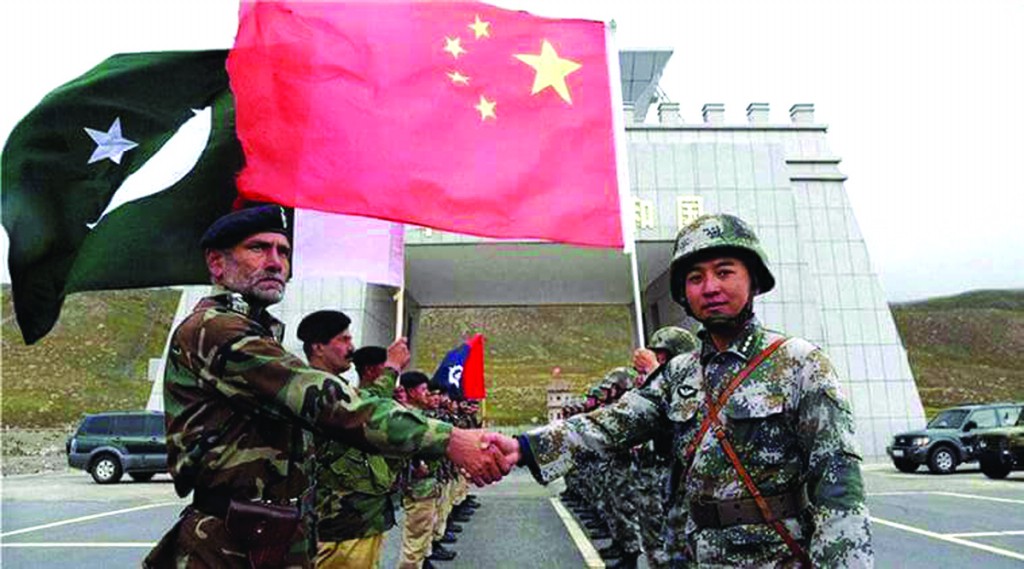
While it was pushing an unabatedly jingoistic agenda across the Subcontinent, diplomatic dynamics have abruptly become complex for India because of an unaccounted-for factor – China.
India’s recent faceoff with China on the long-disputed territory of Ladakh has resulted in losing control over much of India’s perceived area of the actual line of control as the Chinese military successfully managed to station its troops in territories that were once in India’s control. These clashes have sparked a new era of information warfare in mainstream media as the armies of two main countries of the region came to blows, resulting in the killing of at least 20 Indian soldiers. The incident marked the first deadly face-off in the contested area in the last 45 years.
India’s external affairs ministry first accused China of not respecting the actual line of actual control in the Galwan Valley, only to realize the sensitivity of the issue and eventually resorted to addressing the situation diplomatically. The rise in escalation is equally challenging for both nuclear-armed countries as heading towards a full-scale conflict could prove disastrous for the entire region or as alternatively put – for almost forty percent of the human population.
The foreign ministers of both countries recently met at the Shanghai Regional Corporation meeting and gave a joint statement about the tensions between the countries in which both agreed not to accentuate the differences regarding borders into disputes. It was also agreed by the two that the current confrontation in the area of Ladakh is not in favor of both countries hence the confrontation should be resolved with mutual dialogue, maintaining proper distance, and disengaging quickly. Both sides agreed to respect the protocols and agreements between the two countries related to the border issue.
Whilst this joint statement seems to be very positive from both sides, the reality is a bit darker. Chinese forces have not backed off from the large area which they have moved into and have deployed troops in that area. It would appear that China is not planning to leave the area of about 1,000 sq. km which was once under India’s control.
This development has increased the security threat perception for India as this specific area marks the focal point of the region. India has its military deployed in Kashmir and the Himalayan territory of Kashmir is divided between the two rivals India and Pakistan. Rising tensions with China in Ladakh are not a good sign for India as now the chances of India being forced into strategic retreat in the region have increased – with the growing pressure of China from one end and of Pakistan on another. This three-way junction of nuclear-armed countries is an alarming development from the perspective of the world community.

A friendly relationship between Pakistan and China is already very evident: some analysts have speculated that the robust Chinese response in Ladakh might be a response to India for its brutal and violent actions in Kashmir and constant Indian firing at the Pakistani side of the LOC.
Looking at the geostrategic location of the area it can be seen that it is a mountainous tract and the Peoples’ Liberation Army (PLA) is very capable of bearing cold weather when compared to the Indian army. Facing confrontation on both mountainous fronts in the upcoming cold weather is going to pose new challenges for India.
China, being the rising economic power of the world, is now taking full advantage of its muscle and is no longer shy of deploying coercive methods. One of the main reasons for China’s active interest in the region is that the One Belt One Road (OBOR) initiative has parts of Kashmir in it. China is not going to compromise on its commercial expansion through this initiative and because of that, it is slowly expanding the area under its control. India’s unilateral changing of its domestic law regarding Kashmir’s territorial status has thus become one of the main reasons for this dispute between the two Asian Giants. Pakistan and China both condemned this unilateral decision-making from India regarding Kashmir in the UN, but did not receive much meaningful redress there. That could be what prompted Beijing to consider its own means.
The Indian military is aware of the security threat that it now faces from both China and Pakistan. And that is why the Indian Army Chief warned that his country now faces the threat of a two-front war and should be prepared for any challenge posed by China and Pakistan simultaneously. India would need the support of its allies to confront any new moves and defend its security, but looking at the current circumstances of the US with elections coming up and efforts underway to pull troops out of Afghanistan, it becomes difficult to imagine meaningful direct involvement from Washington D.C.
The government of Prime Minister Narendra Modi is already facing a lot of internal challenges because of the fronts opened internally as the BJP pursues an increasingly hardline Hindu nationalist agenda. The country has had a tough time containing its Coronavirus outbreak. External security challenges pile on to this.
In a climate of growing insecurity for India, the most rational outcome is for its government to maintain its soft diplomatic ties with China and Pakistan alike, so that the situation does not get much worse than it already has. India needs to counter this threat very cleverly because an escalation of conflict will not favour any of the three powers involved.
Chinese activity in Ladakh has provided a good margin to Pakistan to step up its own diplomatic efforts to contain Indian assertion at regional and international platforms.
India’s recent faceoff with China on the long-disputed territory of Ladakh has resulted in losing control over much of India’s perceived area of the actual line of control as the Chinese military successfully managed to station its troops in territories that were once in India’s control. These clashes have sparked a new era of information warfare in mainstream media as the armies of two main countries of the region came to blows, resulting in the killing of at least 20 Indian soldiers. The incident marked the first deadly face-off in the contested area in the last 45 years.
India’s external affairs ministry first accused China of not respecting the actual line of actual control in the Galwan Valley, only to realize the sensitivity of the issue and eventually resorted to addressing the situation diplomatically. The rise in escalation is equally challenging for both nuclear-armed countries as heading towards a full-scale conflict could prove disastrous for the entire region or as alternatively put – for almost forty percent of the human population.
The foreign ministers of both countries recently met at the Shanghai Regional Corporation meeting and gave a joint statement about the tensions between the countries in which both agreed not to accentuate the differences regarding borders into disputes. It was also agreed by the two that the current confrontation in the area of Ladakh is not in favor of both countries hence the confrontation should be resolved with mutual dialogue, maintaining proper distance, and disengaging quickly. Both sides agreed to respect the protocols and agreements between the two countries related to the border issue.
Whilst this joint statement seems to be very positive from both sides, the reality is a bit darker. Chinese forces have not backed off from the large area which they have moved into and have deployed troops in that area. It would appear that China is not planning to leave the area of about 1,000 sq. km which was once under India’s control.
This development has increased the security threat perception for India as this specific area marks the focal point of the region. India has its military deployed in Kashmir and the Himalayan territory of Kashmir is divided between the two rivals India and Pakistan. Rising tensions with China in Ladakh are not a good sign for India as now the chances of India being forced into strategic retreat in the region have increased – with the growing pressure of China from one end and of Pakistan on another. This three-way junction of nuclear-armed countries is an alarming development from the perspective of the world community.

A friendly relationship between Pakistan and China is already very evident: some analysts have speculated that the robust Chinese response in Ladakh might be a response to India for its brutal and violent actions in Kashmir and constant Indian firing at the Pakistani side of the LOC.
Facing confrontation on both mountainous fronts in the upcoming cold weather is going to pose new challenges for India
Looking at the geostrategic location of the area it can be seen that it is a mountainous tract and the Peoples’ Liberation Army (PLA) is very capable of bearing cold weather when compared to the Indian army. Facing confrontation on both mountainous fronts in the upcoming cold weather is going to pose new challenges for India.
China, being the rising economic power of the world, is now taking full advantage of its muscle and is no longer shy of deploying coercive methods. One of the main reasons for China’s active interest in the region is that the One Belt One Road (OBOR) initiative has parts of Kashmir in it. China is not going to compromise on its commercial expansion through this initiative and because of that, it is slowly expanding the area under its control. India’s unilateral changing of its domestic law regarding Kashmir’s territorial status has thus become one of the main reasons for this dispute between the two Asian Giants. Pakistan and China both condemned this unilateral decision-making from India regarding Kashmir in the UN, but did not receive much meaningful redress there. That could be what prompted Beijing to consider its own means.
The Indian military is aware of the security threat that it now faces from both China and Pakistan. And that is why the Indian Army Chief warned that his country now faces the threat of a two-front war and should be prepared for any challenge posed by China and Pakistan simultaneously. India would need the support of its allies to confront any new moves and defend its security, but looking at the current circumstances of the US with elections coming up and efforts underway to pull troops out of Afghanistan, it becomes difficult to imagine meaningful direct involvement from Washington D.C.
The government of Prime Minister Narendra Modi is already facing a lot of internal challenges because of the fronts opened internally as the BJP pursues an increasingly hardline Hindu nationalist agenda. The country has had a tough time containing its Coronavirus outbreak. External security challenges pile on to this.
In a climate of growing insecurity for India, the most rational outcome is for its government to maintain its soft diplomatic ties with China and Pakistan alike, so that the situation does not get much worse than it already has. India needs to counter this threat very cleverly because an escalation of conflict will not favour any of the three powers involved.
Chinese activity in Ladakh has provided a good margin to Pakistan to step up its own diplomatic efforts to contain Indian assertion at regional and international platforms.

